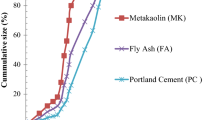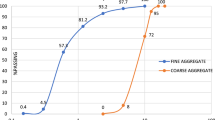Abstract
The purpose of the investigation was to study the effect of binary and ternary blends of cement on the mechanical properties of pervious concrete (PC) specimen through destructive (DT) and non-destructive testing (NDT). Various combinations of fly ash (FA), limestone powder (LP), metakaolin (MK), and silica fume (SF) as mineral admixtures have been investigated to partially replace the cement up to 30% by weight in PC. Standard cube specimens of size 150 mm × 150 mm × 150 mm of binary and ternary blends of mineral admixture of pervious concrete were prepared to conduct standard compressive strength test and split tensile test at 7 and 28 days of curing. The ultrasonic pulse velocity (UPV) test and Rebound Hammer test were used as a non-destructive testing tool to substantiate the robustness of PC and to determine the approximate mechanical properties where other destructive testing tools are not feasible in case of in-place pervious pavements. Overall the pervious concrete made with LP based ternary blends (PLM and PLS) were found to perform better than FA based ternary blends (PFM and PFS) and control mix (PC) in destructive and non-destructive testing.
Similar content being viewed by others
References
ACI 522R-10. Report on Pervious Concrete. Farmington Hills, MI: American Concrete Institute, 2010 (Reapproved 2011)
Neithalath N, Sumanasooriya M S, Deo O. Characterizing pore volume, sizes, and connectivity in pervious concretes for permeability prediction. Materials Characterization, 2010, 61(8): 802–813
Yekkalar M, Haselbach L, Langfitt Q. Testing development of different surface treatments on pervious concrete. Frontiers of Structural and Civil Engineering, 2016, 10(4): 385–393
Obla K H. Pervious concrete—An overview. Indian Concrete Journal, 2008, 84(8): 9–18
Nguyen D H, Sebaibi N, Boutouil M, Leleyteb L, Baraud F. A modified method for the design of pervious concrete mix. Construction & Building Materials, 2014, 73: 271–282
Torres A, Hu J, Ramos A. The effect of the cementitious paste thickness on the performance of pervious concrete. Construction & Building Materials, 2015, 95: 850–859
Yahia A, Kabagire K D. New approach to proportion pervious concrete. Construction & Building Materials, 2014, 62: 38–46
Bonicelli A, Giustozzi F, Crispino M. Experimental study on the effects of fine sand addition on differentially compacted pervious concrete. Construction & Building Materials, 2015, 91: 102–110
Maguesvari M U, Narasimha V L. Studies on characterization of pervious concrete for pavement applications. Procedia: Social and Behavioral Sciences, 2013, 104: 198–207
Giustozzi F. Polymer modified pervious concrete for durable and sustainable transportation infrastructures. Construction & Building Materials, 2016, 111: 502–512
Aamer Rafique Bhutta M, Hasanah N, Farhayu N, Hussin M W, Tahir M M, Mirza J. Properties of porous concrete from waste crushed concrete (recycled aggregate). Construction & Building Materials, 2013, 47: 1243–1248
Peng H, Yin J, Song W. Mechanical and hydraulic behaviors of ecofriendly pervious concrete incorporating fly ash and blast furnace slag. Applied Sciences, 2018, 8(6): 859
Arezoumandi M, Volz J S. Effect of fly ash replacement level on the fracture behavior of concrete. Frontiers of Structural and Civil Engineering, 2013, 7(4): 411–418
Siddique R. Utilization of silica fume in concrete: Review of hardened properties. Resources, Conservation and Recycling, 2011, 55: 923–932
Turkel S, Altuntas Y. The effect of limestone powder, fly ash and silica fume on the properties of self-compacting repair mortars. Sadhana, 2009, 34(2): 331–343
De Weerdt K, Haha M B, Le Saout G, Kjellsen K O, Justnes H, Lothenbach B. Hydration mechanisms of ternary Portland cements containing limestone powder and fly ash. Cement and Concrete Research, 2011, 41(3): 279–291
Siddique R, Klaus J. Influence of metakaolin on the properties of mortar and concrete: A review. Applied Clay Science, 2009, 43(3–4): 392–400
Mehta P K, Gjorv O E. Properties of Portland cement concrete containing fly ash and condensed silica fume. Cement and Concrete Research, 1982, 12(5): 587–595
Ozyildirim C, Halstead W J. Improved concrete quality with combinations of fly ash and silica fume. American Concrete Institute. Material Journal, 1994, 91(6): 587
Thomas M D A, Shehata M H, Shashiprakash S G, Hopkins D S, Cail K. Use of ternary cementitious systems containing silica fume and fly ash in concrete. Cement and Concrete Research, 1999, 29(8): 1207–1214
Lane D S, Ozyildirim C. Preventive measures for alkali-silica reactions (binary and ternary systems). Cement and Concrete Research, 1999, 29(8): 1281–1288
Shannag M J. High strength concrete containing natural pozzolan and silica fume. Cement and Concrete Composites, 2000, 22(6): 399–406
Nesvijski E G. Dry point contact transducers: Design for new applications. The e-Journal of Nondestructive Testing, 2003, 9: ID–1745
Shah S, Subramaniam K V, Popov J S. Compressive strength, use of nondestructive ultrasonic techniques for material assessment and inservice monitoring of concrete structures. In: Proceedings of the International Symposium on Nondestructive Testing Contribution to the Infrastructure Safety Systems in the 21st Century. Torres: Universidade Federal de Santa Maria, 1999, 107–114
Saint-Pierre F, Philibert A, Giroux B, Rivard P. Concrete quality designation based on ultrasonic pulse velocity. Construction & Building Materials, 2016, 125: 1022–1027
Lorenzi A, Caetano L F, Chies J A, Pinto da Silva Filho L C. Investigation of the potential for evaluation of concrete flaws using nondestructive testing methods. International Scholarly Research Notices Civil Engineering, 2014, 2014: 543090
Mandal T, Tinjum J M, Edil T B. Non-destructive testing of cementitiously stabilized materials using ultrasonic pulse velocity test. Transportation Geotechnics, 2016, 6: 97–107
Panzera T H, Cota F P, Borges P H, Bowen C R. Advances in Composite Materials—Analysis of Natural and Man-Made Materials. Rijeka: InTech, 2011
Gehlot T, Sankhla S S, Gehlot S S, Gupta A. Study of concrete quality assessment of structural elements using ultrasonic pulse velocity test. Journal of Mechanical and Civil Engineering, 2016, 13(5): 15–22
Ćosić K, Korat L, Ducman V, Netinger I. Influence of aggregate type and size on properties of pervious concrete. Construction & Building Materials, 2015, 78: 69–76
Indian Standard. IS: 8112. Ordinary Portland Cement, 43 Grade Specifications. New Delhi: Bureau of Indian Standards, 2013
Indian Standard. IS: 2386. Methods of Test for Aggregates for Concrete. Part I: Particle Size and Shape. New Delhi: Bureau of Indian Standards, 1999
Indian Standard. IS: 383. Specifications for Coarse and Fine Aggregates from Natural Sources for Concrete. New Delhi: Bureau of Indian Standards, 2016
Gurbir K, Singh S P, Kaushik S K. Fatigue analysis of fibrous concrete with cement additions. Construction Materials, 2013, 167(2): 79–90
ASTM C1688. Standard Test Method for Density and Void Content of Freshly Mixed Pervious Concrete. West Conshohocken: ASTM International, 2012
Lian C, Zhuge Y. Optimum mix design of enhanced permeable concrete—An experimental investigation. Construction & Building Materials, 2010, 24(12): 2664–2671
Indian Standard. IS: 516. Methods of tests for strength of concrete. New Delhi: Bureau of Indian Standards, 2016
Indian Standard. IS: 5816. Method of Test Splitting Tensile Strength of Concrete. New Delhi: Bureau of Indian Standards, 1999
Ghambhir M L. Concrete Technology. 3rd ed. Patiala: Tata McGraw-Hill Education, 2004
Indian Standard. IS: 13311-1. Method of Non-Destructive Testing of Concrete, Part 1: Ultrasonic Pulse Velocity. New Delhi: Bureau of Indian Standards, 1992
Chandrappa A K, Biligiri K P. Influence of mix parameters on pore properties and modulus of pervious concrete: An application of ultrasonic pulse velocity. Material and Structure, 2016, 49(12): 5255–5271
Indian Standard. IS: 13311-2: Method of Non-Destructive Testing of Concrete-Methods of Test, Part 2: Rebound Hammer. New Delhi: Bureau of Indian Standards, 1992
Neville A M. Properties of concrete. 4th ed. London: Pearson education, 2011
Moesgaard M, Poulsen S L, Herfort D, Steenberg M, Kirkegaard L F, Skibsted J, Yue Y. Hydration of blended Portland cements containing calcium aluminosilicate glass powder and limestone. Journal of the American Ceramic Society, 2012, 95(1): 403–409
Moser R D, Jayapalan A R, Garas V Y, Kurtis K E. Assessment of binary and ternary blends of metakaolin and class C fly ash for alkali-silica reaction mitigation in concrete. Cement and Concrete Research, 2010, 40(12): 1664–1672
Joshaghani A, Ramezanianpour A A, Ataei O, Golroo A. Optimizing pervious concrete pavement mixture design by using the Taguchi method. Construction and Building Materials, 2015, 101: 317–325
Tennis P, Leming M, Akers D. Pervious Concrete Pavements, National Ready Mixed Concrete Association (NRMCA) 2004. Portland Cement Association Skokie Illinois and National Ready Mixed Concrete Association. Maryland: Silver Spring, 2004
Hannachi S, Guetteche M N. Review of the rebound hammer method estimating concrete compressive strength on site. In: Proceedings of International Conference on Architecture and Civil Engineering. Dubai: Conference Publishing Services, 2014, 118–127
Acknowledgements
The authors gratefully acknowledge the support of Prof. S. P. Singh and other staff members of Concrete Structures Laboratories at Dr B. R Ambedkar National Institute of Technology, Jalandhar, India, during the experimentation work reported in the present investigation. This research did not receive any specific grant from funding agencies in the public, commercial, or not-for-profit sectors.
Author information
Authors and Affiliations
Corresponding author
Rights and permissions
About this article
Cite this article
Singh, R., Goel, S. Experimental investigation on mechanical properties of binary and ternary blended pervious concrete. Front. Struct. Civ. Eng. 14, 229–240 (2020). https://doi.org/10.1007/s11709-019-0597-4
Received:
Accepted:
Published:
Issue Date:
DOI: https://doi.org/10.1007/s11709-019-0597-4




